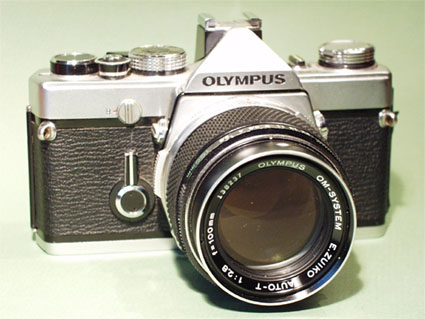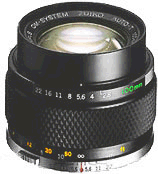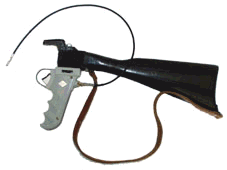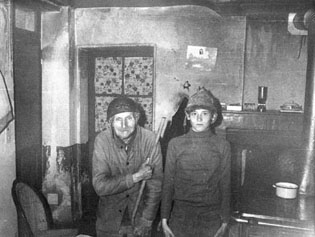
 |
 |
In 1972, the company
Olympus produced its
first
camera under the designation of M-1 but quickly changed
it
in
OM-1 due to a complaint
from
Leica which already used
this designation.
Until then, the
Olympus company was rather considered for its scientific optical devices
(binocular magnifying glasses, microscopes, etc.).
For a first trial, it is a
masterstroke!
This small 35 mm reflex
camera is immediately approved by a large proportion of professional
photographers.
Compact,
light, silent, sturdy,
perfect ergonomics and endowed with a
list of
characteristics and options which has nothing
to envy to
those offered by the traditional manufacturers such
as Nikon, Leica or
Cannon. |
|
The Olympus OM-1 will open a
new era for the reflex photography by inducing a new concept of camera.
Among its numerous characteristics, here are the key ones :
 |
The first thing which is surprising you with an OM-1
camera, is its hand grip.
Despite of its small size (136mm x 83mm x 81mm for a weight of
680g), all its controls are perfectly positioned under your fingers.
|
 |
Have a look inside the viewfinder, it is brilliant!
Normal, the image is 30% larger than any other reflex camera of the
same period. The focusing is done using a frosted glass with prisms.
In fact, 13 different focus glasses were available depending of the
lenses used.
|
 |
The curtain shutter is giving the following speeds :
1sec, 1/2 sec, 1/4 sec, 1/8 sec, 1/15 sec, 1/30 sec, 1/60 sec, 1/125
sec, 1/250 sec, 1/500 sec, 1/1000 sec and pause B.
|
 |
In 1974 Olympus change its OM-1
in order to be able to use one of the winders. After this
modification, the camera takes the new official designation of OM-1MD (Motor Drive).
In order to illustrate this improvement, a small logo is added on
the lower right corner of the front side.
Some OM-1
(as mine) have this improvement without having the logo MD.
|
 |
To suppress vibrations when making macro-photography
and also to allow the furious pace of 5 images per seconde with the
option "Motor Drive", the mirror is can be tipped-up by turning a
lever located on the left of the shutter.
|
 |
Not yet an integrated computer for the time exposure
but two CDS cells located on both sides of the viewfinder and
directly measuring the light through the lens. These cells are
calibrated for a sensibility from 25 to 1600 ASA.
|
 |
The film advance lever is located on the top-right
of the camera body. It is equipped with a security against double
exposures. This security can be unlocked to release the film advance
when rearming the shutter.
|
 |
The OM-1 was offered with a set of 30 different
lenses, all of a top quality, from the famous Fisheye 1:2,8 f=8 mm
to the super telephoto lens 1:11 f=1000mm. |
My Olympus OM-1 and I we have
had a lot of adventures together and I do not count the thousands of
photos I shooted with it ! I've gotten it for my 16 years anniversary (Thanks
Mamy !). This is with this camera that I really started to make
photography.
I have read and read again the Olympus catalogue, dreaming to offer me
the "Winder" option or better, the "Motor Drive" one. Unfortunately,
both were too much expensive for my young budget.
|
 35...
100... 300. 35...
100... 300.
According to the well known rule of the ratio of 3 between each lens
that a true photographer must have, I've bought this camera with a lens
G.Zuiko Auto-W 1:2,8 f=35mm.
Later on, I bought the fabulous E.Zuiko Auto-T 1:2,8 f=100mm. Finally in
1978, I bought 600 Francs in Andorra a telephoto lens Vivitar 1:5,6
f=300mm with a static Olympus fastener. Then, I realized the gap between
regular lenses and compatible ones... |
|

Don't look for that hunting camera's butt
in the Olympus catalogue. It is a home made equipment made in 1978 using
a toy rifle. Needless to say that I came home empty-handed several times
!...
The shutter release grip came from the Agfa movie camera from my Dad.
As I was shooting a lot of photos
with this camera, most of my fortune disappeared in the printing.
Due to that, I decided to use only black & white films and I bought all the
equipment to develop and print my photos (Developing tank Patterson,
Enlarger Rohen, lens Nikon f=50mm).
of photos
with this camera, most of my fortune disappeared in the printing.
Due to that, I decided to use only black & white films and I bought all the
equipment to develop and print my photos (Developing tank Patterson,
Enlarger Rohen, lens Nikon f=50mm).
In fact, each Saturday's evening, until late in the night, I changed the home's bathroom in
a developing labo. I had such a pleasure doing
this !...
A veteran of the WW1
and his grand-son - Armentière, France, 1977
|
 Nombre
de visiteurs Nombre
de visiteurs
Number of visitors |


![]()
